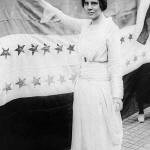“I never doubted that equal rights was the right direction. Most reforms, most problems are complicated. But to me there is nothing complicated about ordinary equality.” – Alice Paul, suffragist and author of the still-not-ratified Equal Rights Amendment
Yesterday, March 22, was World Water Day. That got a modicum of press. But did you  know it was also the 39th anniversary of the date on which Equal Rights Amendment (ERA) passed out of the U. S. Congress and was sent to the states to be ratified? Probably not. And yet, if there is a resource women need as much as clean water, it must be the guarantee of equality under the law.
know it was also the 39th anniversary of the date on which Equal Rights Amendment (ERA) passed out of the U. S. Congress and was sent to the states to be ratified? Probably not. And yet, if there is a resource women need as much as clean water, it must be the guarantee of equality under the law.
The original ERA, introduced in Congress in 1923, was written by Alice Paul, a women’s rights activist instrumental in the 1920 ratification of the 19th amendment, which guaranteed women’s right to vote. Paul also started the National Women’s Party, believing that without a political organization’s clout, women’s concerns would never be taken seriously by politicians. Paul was also one of the few women’s suffrage leaders who realized that getting the right to vote was necessary but not sufficient to enable women to be equal partners in society. She argued that those who had fought for suffrage should then shift their work to getting laws passed that would continue to expand women’s rights.
“When you put your hand to the plow,” Paul said, “you can’t put it down until you get to the end of the row.”
How right she was! And we aren’t there yet.
The ERA has been re-introduced in nearly every session of Congress since , usually with little fanfare and few ripples of serious activist engagement. But this year brought a new surge of activity.
This constitutional amendment that would–IF it had been ratified by 3/4 of the states by its ten-year deadline in 1982– have ensured equal rights could not be denied on the basis of gender is back on the front burner, thanks to Congresswoman Tammy Baldwin’s introduction of a resolution on March 8th (International Women’s Day). Baldwin’s resolution would eliminate the time limit for the ERA to be voted on by state legislatures. And only three 3 more states are needed to finish the job.
Rep. Baldwin’s resolution on ERA did not pass yet, so do check out this Facebook page with the latest information on how to contact your members of Congress to urge them vote for it. Meanwhile ERA activity is bubbling in Florida and Illinois, and the Virginia state Senate passed the ERA with bipartisan support.
It’s nothing short of embarrassing that the U.S. hasn’t passed the Equal Rights Amendment, let alone the UN Convention to End All Forms of Discrimination Against Women (CEDAW), and that’s why it’s critical that we keep our hand to the plow until the ERA is enshrined in our Constitution.
The ERA language is simple:
Section 1. Equality of rights under the law shall not be denied or abridged by the United States or by any state on account of sex.
Section 2. The Congress shall have the power to enforce, by appropriate legislation, the provisions of this article.
Section 3. This amendment shall take effect two years after the date of ratification.
Doesn’t sound very radical now, does it? And that’s precisely my point. Though Paul’s dream of an ERA didn’t pass in her lifetime–she died in 1977–and might not pass in mine, her courageous leadership to initiate this drive for full legal equality for women did foment many advances in employment via Title VII of the Civil rights Act, sports and educational opportunities via Title IX, more women running for political office, and so much more. Could Paul have envisioned Hillary Clinton’s race for president? Or that we have now had three female secretaries of state in a row?
In fact, many people these days will tell you that women’s equal rights are so much a part of the culture that passage of the ERA is moot. My bet is that the ERA will pass within the next decade not because it is still so needed, but because its principles have become so generally accepted by the American public.
As the song says, “You don’t always get what you want, but if you try real hard, you get what you need.”
Alice Paul’s life illustrates brilliantly that one person taking action can make an enormous difference. Her leadership legacy lives on, vibrant and bearing witness to the significance of her life. It should inspire others who struggle for social justice to risk taking the leadership for what they believe.
To help “speed the plow,” by contacting your Congressperson in support of the Equal Rights Amendment, you can also check out the National Organization for Women’s ERA campaign. And you can support filmmaker Kamala Lopez’s public service announcements to educate young people about the importance of passing the ERA.
Gloria Feldt
Latest posts by Gloria Feldt (Posts)
- This Blog is No Longer Active… - March 17, 2014
- Women’s Equality Day and the Civil Rights March - August 26, 2013
- Stuck? Change Your Relationship With Power - July 21, 2013






 "Female Writers Kicking Up Literary Dust"
"Female Writers Kicking Up Literary Dust"
Pingback: Women’s History Roundup: Create a Movement | 9 Ways